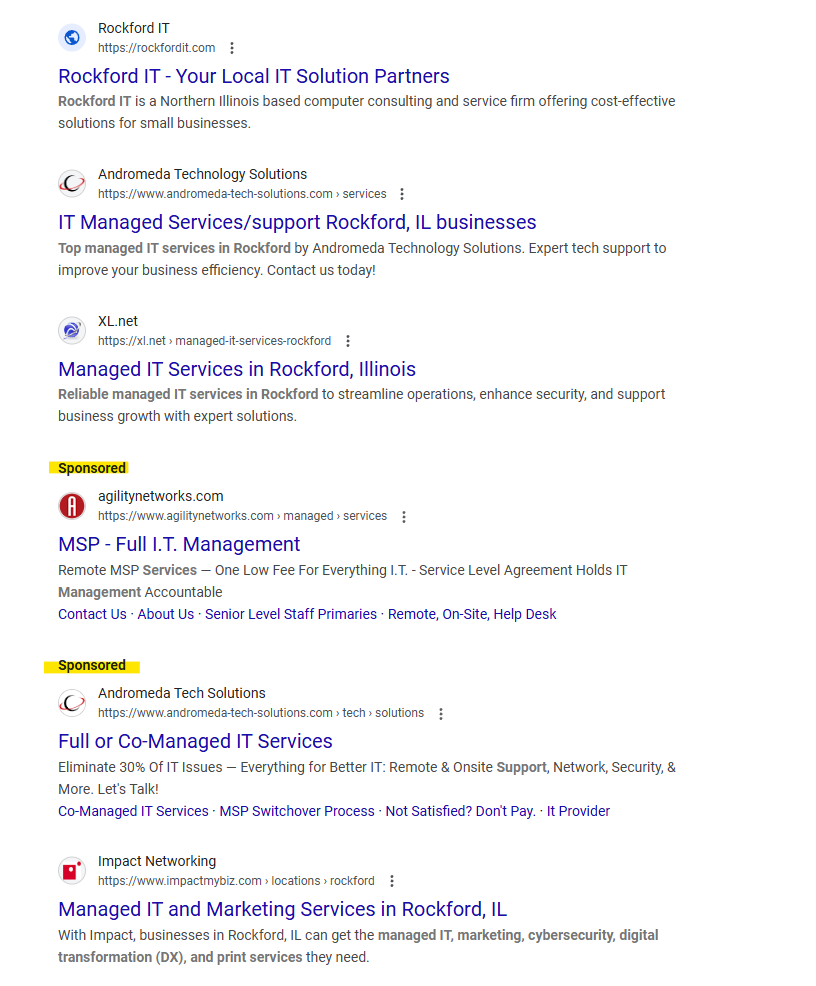New Ads, Who Dis?
Mastering Google's New Ad Placements and Double Serving Policy (Strategies for Maximum SERP Impact)
For digital marketers, these changes are worth a closer look. They affect how visibility is earned, how competition plays out, and how campaigns should be structured going forward. For business owners looking to stay competitive, there’s even more to consider in how these changes will impact strategy in the months ahead.
These updates, however, are different from Google's Double Serving policy. While the position changes create new places for ads to show up (top, middle, bottom), the Double Serving policy determines whether a single advertiser can occupy more than one of those spots. They’re related in that both affect how ads are displayed, but they solve different problems. Position changes create more space; Double Serving changes adjust how that space can be filled.
Together, these policies reshape what’s possible on the SERP. But understanding the distinction between them is key to making the most of the new opportunities.
Unpacking Google's Double Serving Policy Changes
Double Serving has always been a sensitive topic in Google Ads. In simple terms, Double Serving refers to one advertiser showing more than one ad for the same search query. For years, Google’s policy limited this practice to make sure users weren’t overwhelmed by multiple ads from the same company. Typically, even large brands could only show one ad per query, no matter how many campaigns they were running.
The recent update changes that. Now, Google allows advertisers to show multiple ads on the same SERP, but only under specific conditions. The key is that the ads must not be duplicates. Each ad has to offer distinct value, whether through different products, services, or brand entities. This adjustment gives advertisers the chance to expand their presence without spamming the results with identical messages.
This means a company with multiple brands or different divisions can have a larger footprint on the SERP. For example, an umbrella company that owns several brands in the same industry might now see two or even three of its brands appear for a single query, as long as each ad is meaningfully different. Google’s goal here is to preserve a quality user experience by ensuring diversity in what’s shown, even if some ads trace back to the same parent company.
Managing Google Ads can be difficult and expensive.
Hire the experts in Google Ads management.
Why These Updates Matter for Advertisers
At a glance, these updates might seem like small adjustments. But for advertisers, they carry real weight. No longer is the top spot the only game in town. Instead, advertisers have more chances to connect with users throughout their search experience.
Google’s internal testing supports this shift. Ads placed lower on the page showed a 10% improvement in relevance and a 14% increase in conversion rates. It’s a reminder that user behavior isn’t fixed. Many people take their time, scroll further, and weigh their options before deciding what to click.

The Double Serving update also reshapes the competitive landscape. Where once an advertiser was limited to one ad per query, they can now (under the right conditions) occupy multiple positions. This increases brand visibility without flooding users with repetitive messages. It rewards advertisers who can diversify their offerings and tailor their ads to different segments of their audience.
Leveraging New SERP Real Estate for Strategic Advantage
With more ad placements available, advertisers have new opportunities, but also more decisions to make. To get the most out of these changes, it’s important to revisit how keywords, ads, and landing pages work together.
One of the best starting points is alignment. Ads that closely match user intent tend to perform better, no matter where they appear on the page. That means making sure keywords aren’t just broad matches, but are thoughtfully connected to clear, specific landing pages. Think long-tail keywords or tightly focused meta descriptions that make it obvious the page delivers exactly what the user is looking for. Strong alignment improves Quality Score and can lower costs over time, while also making the user journey feel more natural.
It’s also worth leaning on Google’s tools for visibility insights. The 'Top vs. Other' segmentation report, for example, can show how ads perform at different positions. It’s a simple way to see if certain campaigns are finding success lower on the page, or if adjustments are needed. This data can reveal hidden strengths that aren’t obvious when focusing only on top-of-page metrics.
The key is to approach the new SERP layout with flexibility. Testing different combinations of keywords, ad creatives, and landing pages, and paying close attention to how users respond at each position, will often lead to smarter, more sustainable performance gains.
Crafting Compelling Ads for Multi-Placement Opportunities
More ad placements bring more chances to connect, but they also raise the bar for creative strategy. Each ad needs to offer something distinct while still reinforcing the brand’s core message.
A few principles to keep in mind:
Consistency without duplication:
Maintain a common thread across your ads, like tone, brand voice, or visual style. But avoid repeating the same offer or message.
Clear differentiation:
Highlight different products, services, or value propositions. Each ad should feel like a unique solution to the user’s search.
Strategic placement thinking:
Consider how user intent might vary by placement. Mid-SERP ads might benefit from different calls to action than top placements.
AI and machine learning tools can help scale this approach. Dynamic tools, built for producing creative, can generate headline and description variations that still map closely to user intent.
It’s also worth testing how subtle changes, like adjusting tone or highlighting different benefits, perform across positions. Users scrolling through the SERP don’t all have the same mindset. A softer, more informative headline might work well lower on the page, while a clear, direct value proposition might stand out at the top.
The goal here is relevance. Ads that meet users with the right message at the right time (without overwhelming them) tend to perform best, no matter where they appear.
Measuring and Optimizing Performance in the New SERP Landscape
As the SERP evolves, so should the way advertisers measure success. Traditional metrics like click-through rate or average position only tell part of the story. With more placements available and new Double Serving opportunities, it's important to dig deeper into performance patterns and adjust strategies as real data comes in.
This starts with expanding what you track. Metrics that capture placement-specific performance give a clearer view of what’s working.
Essential metrics to monitor:
- Top vs. Other Segmentation: Google’s segmentation reports break down performance by position, helping you see if ads perform differently at the top, middle, or bottom of the page.
- Conversion Rate by Placement: Look beyond clicks. Measuring how well different placements convert can reveal where real value is coming from.
- Impression Share and Overlap Rate: Especially useful if you’re running multiple ads for the same query. These metrics show how often your ads appear together and how often they compete with each other.
Of course, measuring performance is only part of the equation. Acting on that data, and doing it quickly, is where real gains happen. Agile optimization means being willing to adjust bids, creative, and targeting based on what the numbers show, not just what was planned at launch.
Strategies for agile adjustments based on performance data:
- Regular A/B Testing: Test variations in ad copy and landing pages across different placements to find what resonates.
- Bid Adjustments by Placement: Don’t assume one bid fits all. Adjust bids based on where ads perform best to manage spend more effectively.
- Leverage Automation Thoughtfully: Google’s smart bidding strategies can help optimize for conversions or value, but it’s important to monitor and tweak settings based on observed performance patterns.
Ultimately, success typically comes from small, continuous improvements rather than sweeping changes. Monitoring, testing, and adjusting (even in small ways) will usually yield better results over time.
Hot Ads Summer
Success in this new environment is less about casting a wide net and more about catching niche, conversion-ready users. To do this, look at re-aligning your keywords, creative, and landing pages closely to user intent, and approaching every campaign with flexibility and a willingness to test and refine. Metrics like conversion rates by placement and impression overlap offer new ways to spot hidden opportunities and make smarter decisions.
Most importantly, these changes reward thoughtful strategy. Brands that invest the time to differentiate their ads and tune their campaigns to how users actually behave across the page are likely to see the biggest gains.
If you’re ready to rethink your PPC strategy and take full advantage of these updates, RivalMind is here to help. Our team of digital marketing specialists can guide you through building campaigns that not only adapt to today’s landscape but also position your brand for long-term growth.
Looking for more organic website traffic?
Welcome to RivalMind. Our purpose is to help your business thrive. We are a digital marketing agency that offers SEO, PPC, Web Design, Social Media and Video Solutions as tools to our clients for online business development and growth.
Contact us today to get started!
Blog Contact Form
Connect with Us:






